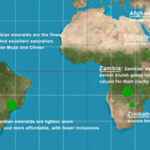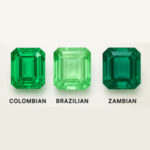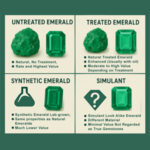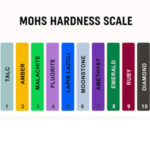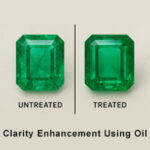emeralds
Emeralds
Gemstones have fascinated cultures across the ages with their beauty, symbolism, and legendary powers. Beyond the “big three” — sapphires, emeralds, and rubies — there are many other captivating stones such as amethyst, garnet, and turquoise. While generally more abundant and accessible, these gems still offer striking beauty and rich variety. Traditionally, the distinction between these and the big three has been based on factors like rarity, brilliance, and color intensity, all of which influence a gem’s appeal and market value. That said, some of these so-called “semi-precious” stones can command prices equal to or even exceeding those of the traditional top-tier gems.

Emeralds: Composition, Formation, and Origins
Emeralds belong to the beryl family, which also includes aquamarine and morganite. While emeralds are defined by their intense green color, they can exhibit a range of green shades, from light to deep forest green. The green hue is attributed to trace amounts of chromium or vanadium in the stone’s composition.
Where Are Emeralds Found?
Emeralds primarily come from three major regions: Colombia, Zambia, and Brazil.
Colombian emeralds are the most valuable, celebrated for their intensely saturated pure green color with warm undertones.
Zambian emeralds are cooler in tone with bluish-green hues and often offer better clarity at a lower price.
Brazilian emeralds are lighter and more transparent, with a delicate appearance but generally less color intensity.
BEAUTY BEGINS WITH COLOR
Emeralds are valued above all for their lush green color, with the finest showing vivid saturation and even tone. A smaller emerald with exceptional color can be worth more than a larger one with a less appealing hue. The most prized stones are highly transparent and fall within the ideal range of bluish green to pure green, with trace elements like chromium and vanadium giving them their signature glow.
Emerald Clarity
Unlike diamonds, where clarity is graded using a loupe, emeralds are evaluated by the unaided eye. Emeralds are a Type III gemstone, meaning they almost always exhibit visible inclusions.
The rare emeralds that show no inclusions to the naked eye are considered exceptionally fine and may cost two to three times more than emeralds of similar color and carat weight.
Natural, Treated, and Synthetic Comparisons
Untreated emeralds are the rarest and most valuable, often showing natural inclusions. Most are treated with oils to improve clarity, which is widely accepted. Synthetic emeralds are lab-grown and share the same properties but are less valuable. Simulants look similar but are made from different materials and hold little value.
Emerald Durability
Emeralds, ranking between 7.5 and 8 on the Mohs scale of hardness, offer a beautiful balance of elegance and strength. While not as hard as sapphires or diamonds, emeralds remain a highly desirable choice for fine jewelry, provided they are worn with care.
Emerald Treatments
Emeralds naturally form with many internal features—called jardin (French for “garden”)—which are small fractures and inclusions. These are part of the gem’s character, but they can affect transparency and beauty.
To improve appearance, most emeralds are treated with oils or resins that fill the surface-reaching fractures, making the gem clearer and more appealing.
valuing emeralds
Valuing emeralds involves assessing factors like color, clarity, cut, carat weight, treatments, and origin. The most prized emeralds display a vivid green hue with minimal visible inclusions. While internal features are common and accepted, fewer inclusions typically increase value. Treatments such as oiling are standard, but untreated stones are rarer and more valuable. Origin also plays a role, with Colombian emeralds often commanding the highest prices
Key Questions to Consider Before Buying an Emerald
Before purchasing an emerald, it’s important to understand the key factors that determine its quality and value. Questions about color, clarity, cut, treatments, origin, and certification can help ensure a confident and informed decision. By addressing these aspects, buyers can better assess an emerald’s beauty, durability, and authenticity.


